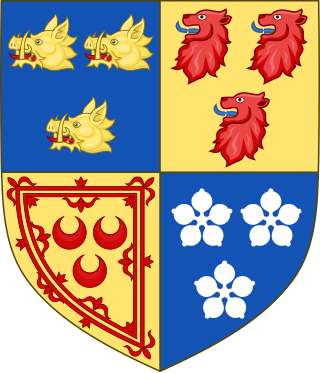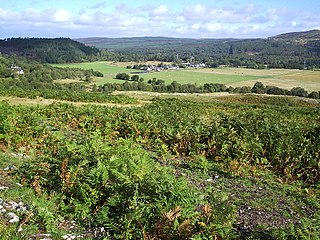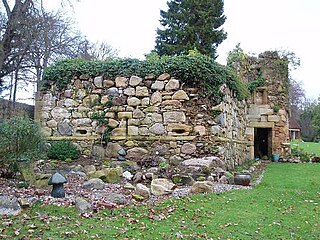Related Research Articles

Duke of Montrose is a title that has been created twice in the Peerage of Scotland. The title was created anew in 1707, for James Graham, 4th Marquess of Montrose, great-grandson of famed James Graham, 1st Marquess of Montrose. Montrose was elevated as a reward for his important support of the Act of Union. It has remained since then in the Graham family, tied to the chieftainship of Clan Graham.

George Gordon, 2nd Marquess of Huntly, styled Earl of Enzie from 1599 to 1636, eldest son of George Gordon, 1st Marquess of Huntly by Lady Henrietta Stewart, daughter of Esmé Stewart, 1st Duke of Lennox, born at Huntly Castle, Huntly, Aberdeenshire, in Scotland was brought up in England as a Protestant, and later created Viscount Aboyne by Charles I.

George Gordon, 1st Marquess of Huntly was a Scottish nobleman who took a leading role in the political and military life of Scotland in the late 16th century, and around the time of the Union of the Crowns.

John Campbell, 1st Earl of Loudoun was a Scottish politician and Covenanter.

David Leslie, 1st Lord Newark was a Scottish military officer and peer. During the Thirty Years' War, he joined in the Swedish Army in 1630 and served under Alexander Leslie. Returning to Scotland in the final days of the Bishops' War, Leslie fought in the English Civil War and Scottish Civil Wars on the side of the Covenanters and Royalists. After the Stuart Restoration, Leslie was raised to the peerage of Scotland as Lord Newark by Charles II of Scotland.

Clan Gordon is a Highland Scottish clan, historically one of the most powerful Scottish clans. The Gordon lands once spanned a large territory across the Highlands. Presently, Gordon is seated at Aboyne Castle, Aberdeenshire. The Chief of the clan is the Earl of Huntly, later the Marquess of Huntly.

William Keith, 7th Earl Marischal was a Scottish nobleman and Covenanter. He was the eldest son of William Keith, 6th Earl Marischal.

The Battle of Carbisdale took place close to the village of Culrain, Sutherland, Scotland on 27 April 1650 and was part of the Wars of the Three Kingdoms. It was fought by the Royalist leader James Graham, 1st Marquess of Montrose, against the Scottish Government of the time, dominated by Archibald Campbell, 1st Marquess of Argyll and a grouping of radical Covenanters, known as the Kirk Party. The Covenanters decisively defeated the Royalists. The battlefield has been inventoried and protected by Historic Scotland under the Scottish Historical Environment Policy of 2009. Although Carbisdale is the name of the nearest farm to the site of the battle, Culrain is the nearest village.

Clan Crichton is a Lowland Scottish clan that historically ruled Dumfries.

Clan Ogilvy, also known as Clan Ogilvie, is a Highland Scottish clan. Originating from Angus, Scotland, the progenitor of the Clan received a barony from King William the Lion in 1163. In 1491, King James IV elevated Sir James Ogilvy as Lord Ogilvy of Airlie.

Sir George Munro, 1st of Newmore (1602–1693) was a 17th-century Scottish soldier and shire commissioner of Parliament from the Clan Munro, Ross-shire, Scotland. He was seated at Newmore Castle. Between 1629 and 1634 Munro held command in the Swedish army during the Thirty Years' War, and from 1642 in the Scottish Covenanter army during the Irish Confederate Wars before changing his allegiance to the Royalist cause of Charles I in 1648 during the Scottish Civil War and Irish Confederate Wars.
Margaret Stewart was the younger daughter of James II of Scotland and Mary of Guelders. Once engaged to the Lancastrian Prince of Wales, Margaret instead became the mistress of William Crichton, 3rd Lord Crichton, and the mother of his illegitimate daughter, Margaret Crichton, later Countess of Rothes, and his son, Sir James Crichton, progenitor of the Viscounts of Frendraught. Margaret and Lord Crichton may have been married later, after the death of Crichton's wife.
George Livingston PC was a military officer and third Earl of Linlithgow.
George Ogilvy, 1st Lord Banff was a Scottish royalist army officer.

George Hay, 3rd Earl of Kinnoull was a Scottish peer and military officer. He was an active supporter of King Charles I during the English Civil War.

Viscount of Frendraught was a title in the Peerage of Scotland.

John Lindsay, 17th Earl of Crawford, 1st Earl of Lindsay was a Scottish nobleman.
Frendraught Castle or House is a 17th-century house, about 6 miles (9.7 km) east of Huntly, Aberdeenshire, Scotland, and 1 mile (1.6 km) west of Largue, on the site of a 13th-century castle.
John Gordon, 13th Earl of Sutherland (1576–1615) was a Scottish landowner and courtier.

James Crichton of Frendraught or Frendraucht (1599-1667) was a Scottish landowner and survivor of the Fire of Frendraught in October 1630. Several of his guests were killed at Frendraught Castle and arson was suspected, though the facts of the case were widely disputed and remain unresolved.
References
- 1 2 3 Rigg 1888.
- 1 2 Douglas's Peerage of Scotland, i. 611
- ↑ Temple, William (1894). The Thanage of Fermartyn, including the district commonly called Formartine, its proprietors, with genealogical deductions; its parishes, ministers, Churches, churchyards, antiquities, &c. Aberdeen: Wyllie. p. 152.
{{cite book}}: CS1 maint: date and year (link)
- Attribution
![]() This article incorporates text from a publication now in the public domain : Rigg, James McMullen (1888). "Crichton, James (d.1650)". In Stephen, Leslie (ed.). Dictionary of National Biography . Vol. 13. London: Smith, Elder & Co. p. 91.
This article incorporates text from a publication now in the public domain : Rigg, James McMullen (1888). "Crichton, James (d.1650)". In Stephen, Leslie (ed.). Dictionary of National Biography . Vol. 13. London: Smith, Elder & Co. p. 91.